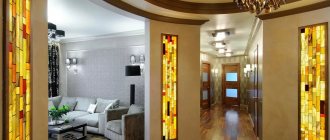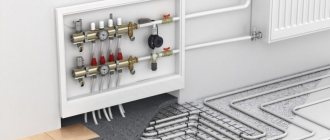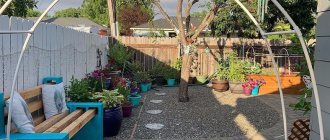The housing issue still remains a pressing problem in our country. The high cost of finished housing, as well as land and building materials for construction, forces many families to rent an apartment or take out a mortgage, deliberately driving themselves into debt bondage for many years. Buying a mobile home will solve your housing problem. From this article, readers will learn about the advantages of such housing.
Autonomous house project
Before starting the construction of a residential building, you should draw up its drawings indicating how to supply all the necessary communications. An autonomous house will be comfortable only if it has:
- electricity,
- gas,
- heating,
- water pipes,
- sewerage
We’ll talk further about how exactly all these types of communications can be connected if the house is located far from centralized engineering systems.
General information
Let's look at the very concept of “autonomous home”. It is a house that is independent of city communications. Later in the article you will learn more about this concept.
What does living in a house depend on? First, let's find out what the ordinary houses we are used to depend on:
- From electrical energy ( the nearest distribution zone).
- From gas supply ( nearest regional gas supply).
- From sewerage and water supply ( water utility in your area, if available).
As a rule, it is possible to resolve the issue of water supply and sewerage without the direct participation of the local water utility - this will require drilling a well and installing a cesspool or septic tank, so we will not consider this point in detail. Let's talk about more important things.
Gas - most often it is used to heat a house and heat hot water. Electrical energy - for the operation of all electrical appliances in the house (and sometimes for heating). Now it’s worth considering the pros and cons of a house, which is also called an energy-dependent house.
| Advantages | Flaws |
|
|
The list of advantages and disadvantages of the house was taken from the experience of the builders and from customer reviews. It could have been larger, but only the main milestones were taken into consideration.
Electricity supply
The most difficult thing is to make an autonomous house comfortable for living if it is located far from power lines. There are three ways to ensure a stable power supply to a building:
- By installing a generator that runs on liquid fuel. Such equipment solves the problem of providing buildings with electricity very effectively. By connecting a pump and a boiler to the generator, you can equip your house with water supply and heating. The disadvantages of this method of power supply to a private home include only the rather high cost. Liquid fuel is expensive today, and you will need a lot of it. In addition, you will have to build a separate room with good sound insulation for the generator.
- By installing a wind farm. This method is highly economical. You won't have to pay a penny to receive electricity. However, the initial costs will be very high. After all, it’s not enough to just install a windmill. You will also need equipment to accumulate energy and convert direct current into alternating current.
- Having assembled a mini-hydroelectric power station. This method is good if a river or large stream flows near the house.
- By installing solar panels. In this case, you also won’t have to pay for electricity. However, such equipment will be very expensive.
Most often, houses in remote areas are electrified using generators. If there are other buildings nearby, it makes sense for neighbors to chip in and install a wind generator that provides electricity to all houses at once. Mini-hydroelectric power stations and solar panels are practically not used in our country.
Solar architecture
Housing design should be carried out on the basis of strict consideration of the natural and climatic features of the region using the achievements of traditional construction. The foundations of this approach were laid by F. L. Wright. The steep slope of the roof is oriented to the south, the longer, gentle slope is oriented to the north, because in this case, it better withstands snow and wind loads. The basement and ground floors, attics are heavily insulated, the entrance to the house is through a vestibule. The main openings, protected by shutters, are oriented to the south. The space-planning solutions of these houses serve as the basis for the design of solar houses in cold climates. Thus, even in a traditional home, natural and climatic conditions significantly change the appearance of the house. Climate differentiation is especially important when designing solar houses. Experts in terms of the level of use of environmental resources distinguish several types of residential buildings: * an energy-efficient building, the heat loss of which is minimized due to the choice of the optimal space-planning solution and enhanced thermal insulation; * an energy efficient building with enhanced absorption of solar radiation, but without devices for accumulating the resulting heat; * a building with minimal energy losses, which has special heat absorption, distribution and accumulation systems (solar house).
How to choose a generator for your home
Autonomous power supply to a building erected in a remote area is usually arranged taking into account the following recommendations:
- If the building is located next to a power line, but the supply of electricity is irregular, it is advisable to use a gasoline generator. Such models are usually not too expensive, but their resource is somewhat limited.
- Fully autonomous power supply is usually arranged using a diesel generator. This is very productive equipment designed for long-term operation.
- The power of the generator is determined by adding the powers of all consumers plus a margin of 15-20%. In small country houses, gasoline models with a power of up to 2 kW are usually used to provide emergency power supply. For residential buildings, diesel generators with a power of 30 kW or more are often chosen. This equipment is capable of providing a country house with uninterrupted electricity.
I'm starting to collect
Before purchasing and assembling, it is necessary to calculate the entire system so as not to make a mistake with the location of all systems and cable routing. From the solar panels to the inverter I have about 25-30 meters and I laid two flexible wires with a cross-section of 6 sq. mm in advance, since they will transmit voltage up to 100V and a current of 25-30A. This cross-sectional margin was chosen to minimize losses on the wire and maximize energy delivery to the devices. I mounted the solar panels themselves on homemade guides made of aluminum corners and attached them with homemade fasteners. To prevent the panel from sliding down, a pair of 30mm bolts point upward on the aluminum corner opposite each panel, and they act as a kind of “hook” for the panels. After installation they are not visible, but they continue to bear the load.
The solar panels were assembled into three blocks of 3 panels each. In the blocks, the panels are connected in series - this way the voltage was raised to 115V without load and the current was reduced, which means you can choose wires of a smaller cross-section. The blocks are connected in parallel to each other using special connectors that ensure good contact and tightness of the connection - called MC4. I also used them to connect wires to the solar controller, as they provide reliable contact and quick closing/opening of the circuit for maintenance.
Next we move on to installation in the house. The batteries are pre-charged with a smart car charger to equalize the voltage and are connected in series to provide 48V. Next, they are connected to the inverter with a cable with a cross-section of 25 mm square. By the way, when you first connect the battery to the inverter, there will be a noticeable spark at the contacts. If you have not mixed up the polarity, then everything is fine - the inverter has fairly capacious capacitors installed and they begin to charge the moment they are connected to the batteries. The maximum power of the inverter is 5000 W, which means the current that can pass through the wire from the battery will be 100-110A. The selected cable is sufficient for safe operation. After connecting the battery, you can connect the external network and the load at home. Wires are attached to the terminal blocks: phase, neutral, ground. Everything here is simple and clear, but if it is unsafe for you to repair the outlet, then it is better to entrust the connection of this system to experienced electricians. Well, the last element is connecting the solar panels: here, too, you need to be careful and not mix up the polarity. With a power of 2.5 kW and incorrect connection, the solar controller will burn out instantly. What can I say: with such power, you can weld directly from solar panels, without a welding inverter. This will not improve the health of solar panels, but the power of the sun is really great. Since I additionally use MC4 connectors, it is simply impossible to reverse the polarity during the initial correct installation.
Everything is connected, one click of the switch and the inverter goes into setup mode: here you need to set the battery type, operating mode, charging currents, etc. There are quite clear instructions for this, and if you can cope with setting up the router, then setting up the inverter will not be very difficult either. You just need to know the battery parameters and configure them correctly so that they last as long as possible. After that, hmm... After that comes the fun part.
Features of gasoline and diesel generators
Gasoline autonomous power plants for home can be designed for 500 or 1500 hours of operation. In this indicator, they are significantly inferior to diesel models. There is also professional equipment of this type on the market, designed for 3000 operating hours. But such generators are quite expensive.
Diesel models are reliable and have a long service life. The only inconvenience that arises when using them is the need to run at full load every 100 hours. The fact is that this type of equipment does not tolerate idling particularly well.
Wind turbines
The design of autonomous stations of this type usually includes the following elements:
- Blades, rotor and generator mounted on a mast.
- Rechargeable batteries with charge controller.
- Inverter for converting current.
- Electric drive for orientation following the wind direction.
- A sensor that monitors the movement of air masses.
- Emergency stop system (used in stormy winds).
- Automatic switch to diesel generator or centralized power supply system.
How to choose
The efficiency of a wind generator depends on two main factors: wind speed and blade area. For example, from 1 m2 of receiving device at a speed of movement of air masses of 3 m/s, you can get about 6.5 W of energy, at 21 m/s - 2.2 kW. For a small country house, installations with a power of no more than 0.1-2 kW are usually chosen. For a residential building you will need equipment of at least 20 kW when using an electric boiler. An autonomous house, the design of which includes gas heating, solid fuel or liquid fuel, is usually electrified from a 5 kW wind generator. Such equipment will be quite sufficient for the uninterrupted operation of basic household appliances - refrigerator, TV, computer, washing machine, etc.
Autonomous gasification
In order for living outside the city to be comfortable, of course, it is necessary not only to provide an autonomous house with an electricity supply. The building must also be gasified. If for a stove it is enough to buy a cylinder and refill it every 3 months, then to install a heating system you will have to purchase much more complex equipment.
Large tanks, which are used to install autonomous gas heating at home, are called gas holders. They are usually filled with a mixture of propane and butane and are designed for pressures up to 1.6 MPa. Such containers can have different sizes - from 2700 to 20,000 m3. For a private house with an area of 200 m3, using a gas holder of a minimum volume will be quite sufficient.
Where should I start?
Now you know which autonomous systems individually make up an autonomous house, but how to start construction?
- First, decide whether a site with communications is needed. If not, then buying a plot of land will cost much less.
- Afterwards we will solve the issue of housing area. With the same budget, you can build a house of both 300 m2 and 150 m2. In the second case, the house will be more technologically advanced and more modern.
- Don't forget that even well-insulated houses will consume about 200 kWh/year*m2 (not to be confused with a passive house). The larger your home, the more you will spend on maintaining it. With prices constantly rising, this may become an unpleasant surprise.
- Remember that the money invested in insulation will pay off faster than energy-efficient equipment.
- If you want to use new technologies, look at how it will fit in with them. First, engineering solutions are discussed, and then design. Discuss with specialists what engineering systems can be used in your home and what area they will occupy, and where best to place them. Only after this can the project be approved.
- If you are building a home for the first time, try to hire as few contractors as possible. Since you are not a specialist, it will be difficult for you to figure out where the powers of one end and the responsibilities of the second begin. As practice shows, it is much easier to ask everything from one person. At the same time, find out if you can purchase materials in one place to get a discount for purchasing in bulk.
- Effective use will be guaranteed by the responsibility and professionalism of specialists. Check the possibility of combining all technologies and creating a “turnkey”
- Try to find specialists who will answer all your questions in clear language. Don’t be shy and ask them to tell you about all the advantages, disadvantages and pitfalls. You have the right to ask about everything and more than once until the complete picture emerges.
Registration of connection
You cannot install this equipment yourself. You need to contact a private or regional gas company. In the first case, the cost of work will be slightly higher. The fact is that autonomous gasification of a home is possible only after obtaining various types of permits. Private firms usually take care of collecting all the necessary documentation. When contacting a regional company, you will have to go through the authorities on your own.
A hole of appropriate size is dug under the gas tank. The tank is installed on a metal base. A trench is dug to the house from it and a highway is laid. Before starting up the equipment, testing activities are carried out in the presence of representatives of Rostechnadzor.
Video: setting up all functions on Arduino
To start setting up a “smart home” using the Arduino program, you will need the following components:
- processor board,
- module,
- all necessary sensors,
- microphone,
- switches,
- a resistor with a resistance of about 4.7 kOhm,
- cables.
If you buy all of these systems separately, you can spend about a hundred dollars. This is why Arduino is so popular. After all, if you have certain skills in working with the system, you can significantly save on installation. Next, you need to connect the entire system, including microphone sensors, to the processor on the Arduino board.
Connection diagram to the Arduino platform
Writing a program yourself is quite easy. For this, Arduino has dedicated a special text editor and other developments that help even a novice programmer avoid serious mistakes. However, if you have never encountered such tasks before, you can use ready-made libraries. All sketches (user programs) that work for Arduino have already been posted on the Internet. You just need to download the program, unpack it and transfer it to Arduino.
In order to control the operation of the program, you will need to install a special application on your smartphone or tablet - SmartHome.apk. It runs on the Android platform and helps control the operation of the system, checking information at any time convenient for you.
It should be noted that over time, many users began to notice some shortcomings in the operation of the Arduino software. For example, there are problems with the operation of the temperature sensor, which gives an error of several degrees. In addition, there may be a malfunction of the system responsible for opening and closing the doors and windows of the house. To avoid these and several other problems, you need to buy high-quality and proven equipment, and not cheap fakes. Sensors from unknown brands with low cost are not the most successful investment in a smart home system.
Heating
An autonomous country house can be heated in different ways. Typically, installation of a heating system in a residential building in the absence of centralized engineering systems includes the following steps:
- Boiler installation. Currently, both electric and gas, as well as solid fuel and liquid fuel varieties of this equipment are produced. The first option is chosen if there is a wind generator of sufficient power. A gas boiler is connected to the tank with propane and butane, respectively. In all other cases, solid fuel or liquid fuel boilers are used. The first type is more economical. Equipment running on liquid fuel is more convenient to use.
- Installation of highways. Currently, autonomous heating of a house is usually arranged using polypropylene, steel or metal-plastic pipes.
- Installation and connection of batteries. The most popular type at the moment are bimetallic radiators. Slightly cheaper and less durable aluminum models are also sometimes used.
- Installation of the expansion tank. Depending on the design, it is located either next to the boiler or in the attic of the building.
- Installation of a circulation pump. It is placed on the bypass on the return pipe in close proximity to the boiler. A filter is placed in front of the pump to clean the coolant.
- Setting up a security group.
- Pressure testing and start-up.
Today, an autonomous house, located far from centralized engineering systems, is most often heated using liquid fuel boilers. However, since this type of equipment is quite expensive, gas installations powered by tanks, as well as electric models powered by large windmills, have recently become increasingly popular.
Sewer rivers, eco-friendly banks
Sewerage
Did you know that the main consumers of household water are showers and toilets? It is there that up to 70% of the fresh water consumed by the owners of an ordinary house or apartment is consumed. And only the remaining 30 are spent on cleaning, washing, washing and preparing “daily bread”.
But if you change priorities and rearrange the numbers... How? And it’s very simple to install, for example, water-saving plumbing fixtures in an autonomous house. Actually, what’s stopping you from installing a waterless composting toilet in your off-grid home? Or use biological treatment systems that are not at all secret today, but oh so effective? Organic waste should not be thrown away or burned, but disposed of in a composting bioreactor.
But even here an alternative is possible - if you don’t like this option - build a mechanical septic tank from 2-4 communicating tanks. Practice shows that even a child can calculate the volume of each:
V = 200 x N, where
V – volume of one septic tank;
200 – coefficient (200 liters of sewage per person);
N – number of family members (from time to time the visiting mother-in-law may not be counted).
Water pipes
At the moment, only two types of heating boilers are produced - single-circuit and double-circuit. For a house located in a remote area, the second option will be the most suitable. When using a double-circuit boiler, you can install not only heating in your home, but also full plumbing.
Well drilling is usually entrusted to a company specializing in this. The cost of their services depends on the depth of groundwater in the area. To save money, it is worth pre-ordering geodetic surveys on the territory. The water pipe is brought to the house through a trench with a depth no higher than the freezing level of the soil. Internal wiring is carried out according to the project with the connection of the hot water line to the boiler.
Options for DIY construction
In addition to purchasing a ready-made mobile home , you can build a house according to your own design. You can order it, or you can make it yourself. There are special programs that allow you to design any structure using a computer, for example “House-3D” (see Programs for designing houses).
Mobile home project
Mobile home layout
To build yourself, you can go several ways.
- Weld a strong metal frame that can withstand lifting by a truck crane or jacks if it needs to be loaded for transportation. And then this frame is sheathed, insulated and communications are carried out.
- Use a ready-made metal container for construction. They have sufficient strength and can be easily lifted and transported. When converting it into a living space, it is enough to make the necessary openings, insulate it and install communications.
A small house based on a container with a pile foundation.
Considering their several sizes, you can get housing with different usable areas. Well, as an option, you can easily create a modular house from them. - Wood is less durable, and making a frame that can be easily loaded and transported is more difficult, but not impossible. It all depends on the size. You can simply build a wooden house on a metal frame or on a trailer. Wood, of course, is preferable, as it is warmer and lighter.
Autonomous wastewater disposal system
While power lines and even gas mains are available in almost any village, most residents of remote settlements do not even dream of sewerage. Almost all owners of country real estate are faced with the need to install such a system as an autonomous sewerage system in a private house. It is assembled like this:
- The central riser is being installed. In a one-story house, its installation is not necessary, but desirable.
- At a distance of no less than 5 and no more than 15 meters from the house, a hole is dug and a septic tank is installed.
- A pipeline is dug from it to the building below the soil freezing level. The trench must have a slope of at least 3 cm per linear meter.
- Most often, autonomous sewerage in a private house is assembled using polyethylene, polypropylene or metal-plastic pipes. Before laying them, the bottom of the trench is paved with crushed stone. The pipes are covered first with sand and then with earth. Sewer system bends may only be installed at an obtuse angle.
- Wiring inside the house is carried out in compliance with SNIP standards. You should not place the toilet above the kitchen or living areas. The distance between plumbing fixtures should not be less than 25 cm. The toilet is located in close proximity to the riser. The further away it is installed, the greater the likelihood of blockages. Washing machines and dishwashers are connected to the deck using flexible pipes. Siphons must be installed under the bathtub and sink.











